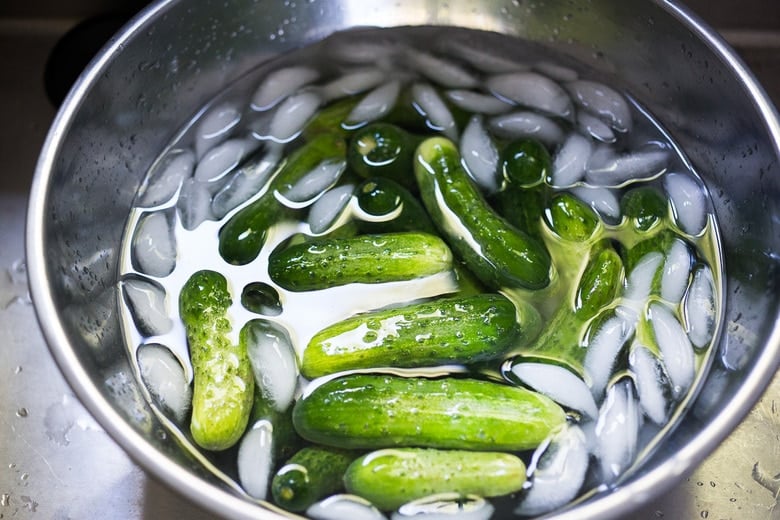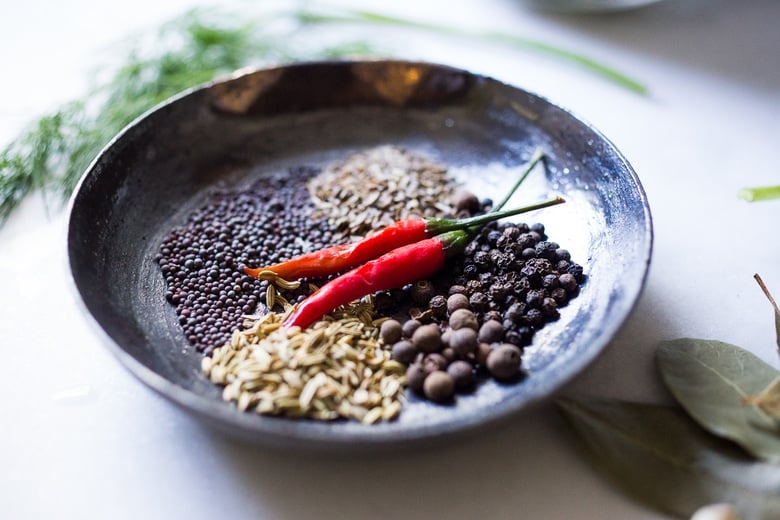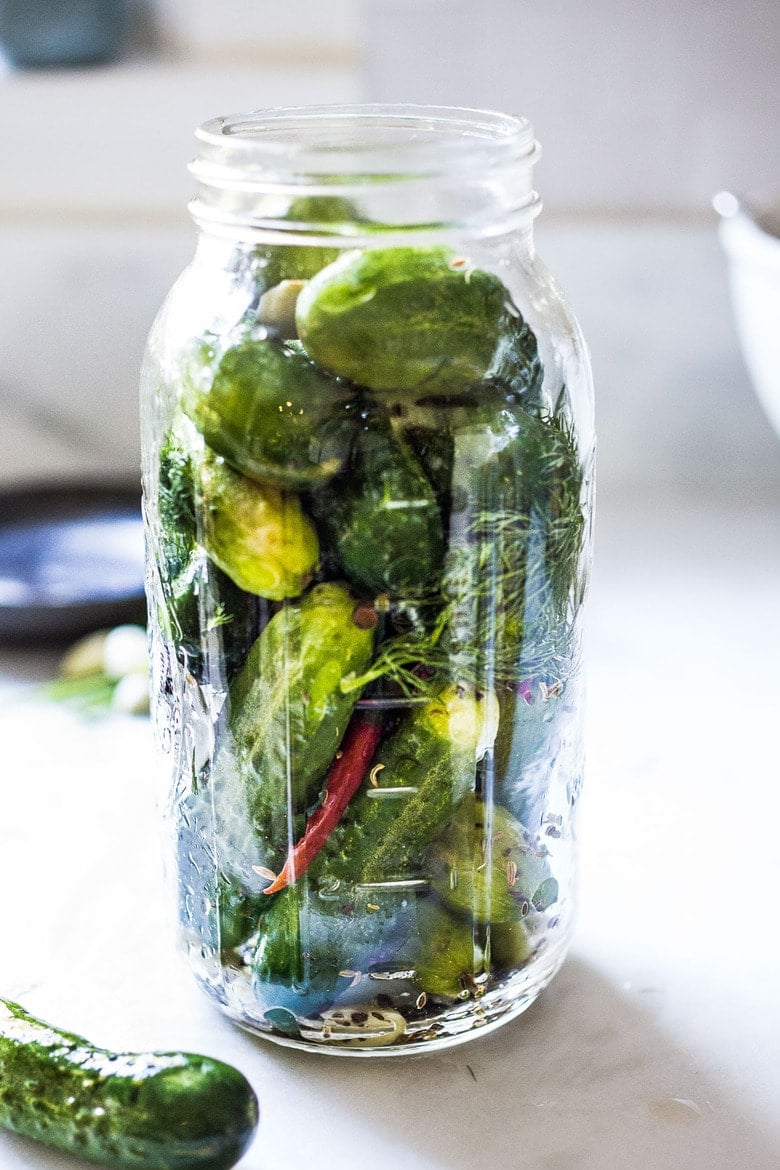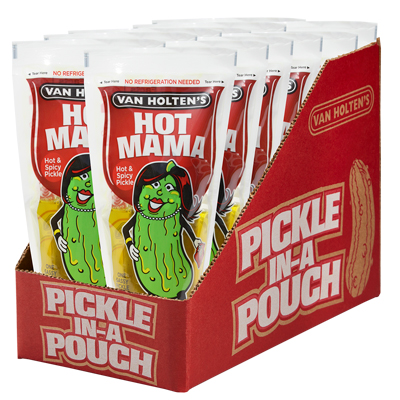You are using an out of date browser. It may not display this or other websites correctly.
You should upgrade or use an alternative browser.
You should upgrade or use an alternative browser.
When making Pickles...
- Thread starter jack
- Start date
Rusty Shackleford
Member
I get the brine boiling then throw the cukes in and once they turn dark green I put the pot in the freezer and let them cool. Because I cool them really fast, they stay crunchy. Once they're fully cooled I put them in quart containers and poor the brine over them. I let that sit over night in the fridge. They are usually good the next day, but the longer they sit in the brine, the better.
Rusty Shackleford
Member
I use salt, water and vinegar. So for every amount of vinegar, I double the amount of water. Three cups of vinegar, six cups of water, half a cup of salt. That's the base, you can add whatever else for flavor. That will make about three quarts.I love my salt brine pickles. Crisp, delicious and I also put a red serrano pepper in the jar.
pre and pro biotics abound!
That looks good. But I prefer whiskey inside my hollowed out pickle like I had at Picklepalooza.
I get the brine boiling then throw the cukes in and once they turn dark green I put the pot in the freezer and let them cool. Because I cool them really fast, they stay crunchy. Once they're fully cooled I put them in quart containers and poor the brine over them. I let that sit over night in the fridge. They are usually good the next day, but the longer they sit in the brine, the better.
How do you pickle without a pressure canner? I looked into getting one but found a quality American made one costs over $400 and I am not sure I will use it enough to justify the price. There shitty Chinese made ones at Walmart for $80 but the reviews are terrible wrt quality.
Rusty Shackleford
Member
I developed a new technique, I cook them very briefly. It infuses the brine into the cucumbers, but you got to chill them rapidly or they turn to mush. For all internets and purposes, they end up pickled.How do you pickle without a pressure canner? I looked into getting one but found a quality American made one costs over $400 and I am not sure I will use it enough to justify the price. There shitty Chinese made ones at Walmart for $80 but the reviews are terrible wrt quality.
jack
The Legendary Troll Kingdom
Huh...must be the difference between pickling and fermenting.

Gather your fresh Garlic and Dill and pickling spices.

I add a lot of garlic… 10-15 cloves!
Layer the spices, cucumbers, garlic, dill and bay leaves and more cukes, in a large two-quart jar (half-gallon). Press everything down.

Carefully measure and mix salt and water to create the salt water brine- then pour this brine over the pickles leaving an inch of headroom.
Note: If the cucumbers or seeds are not submerged under the brine and become exposed to air- they will develop mold.
Step 6: Cover loosely with a lid or towel (to prevent bugs or flies from coming in, and to allow gases to escape) place in a bowl or pan to catch any overflow, and place in a cool dark place for 3-7 days, like the basement.
TIP: I’ve found a slower, cooler, fermentation works best here (60-65F).
Step 7: Check after 2-3 days. Look for signs of life: bubbles/ cloudy water. Tap the jar and see if bubbles rise to the top. Check to see if any brine overflowed into the bowl ( both signs of life). This often takes about 3-5 days depending on temperature. Cloudy brine is a good thing!
Step 8: Place the jar in the fridge to further slow the fermentation with a loose lid.
Voila! Recipe here https://www.feastingathome.com/fermented-pickles/
- Use Pickling Cucumbers! Small and short ( 4-6 inches) with thin bumpy skin, crisp texture, small seeds, a blocky shape and color gradient from light to dark. Varieties include Kirby, Calypso, Royal, Pickalot, National Picking, Adam Gherkin, Sassy, Eurika, Jackson, Boston Pickling, Northern Pickling… to name a few.
- You’ll need 2 lbs of “pickling cucumbers.” This recipe makes one large 1/2 gallon jar (or use two quart-sized jars) – a relatively small batch.
- They are most easily found at your local farmers’ market. Ask the farmers if they have “pickling cucumbers” they can help direct you to the right ones.
- Your pickles will only be as good as your cucumbers, so choose wisely!
- Make sure they are roughly the same size -about 4-5 inches long with 1 1/2-inch to 2-inch diameters – to fit in the jar nicely and ferment at the same rate. Handpicked each one. They should be fresh and crisp with no soft spots.

Gather your fresh Garlic and Dill and pickling spices.

- Use fennel seeds, mustard, peppercorns, coriander seeds, allspice, dill seeds and celery seeds. Feel free to change or embellish! I added a couple of chilies for a little heat.
- Fresh Dill and lots of garlic!
- Fermented cucumbers need tannin to help keep their skins from going soft. Traditionally, a few grape leaves are used, but bay leaves work well too!
I add a lot of garlic… 10-15 cloves!
Layer the spices, cucumbers, garlic, dill and bay leaves and more cukes, in a large two-quart jar (half-gallon). Press everything down.

Carefully measure and mix salt and water to create the salt water brine- then pour this brine over the pickles leaving an inch of headroom.
How salt works in fermentation:
- In a nutshell, using the right ratio of salt in fermentation encourages the growth of healthy bacteria while at the same time kills off bad bacteria. You want to be precise when measuring the salt and water in these kinds of recipes.
- Too much salt may kill off ALL of the bacteria -preventing fermentation.
- Too little salt will allow bad bacteria to keep on living. It is a fine balance.
SALT TO WATER RATIO (fermented dill pickles):
- This recipe is a 3 % saltwater brine, which is considered “safe”. It equals 7 grams of salt per one cup of water. This ratio allows one to drink the brine (like a shot) because it is not too salty.
- If you want a stronger brine or longer ferment, feel free to go up to 4.5%. So for example, 3.5% Ratio= 9 grams of salt per 1 cup of water, 4.5% brine =10.8 grams of salt ( 2 tsp salt) per 1 cup of water.
- Use fine, unprocessed salt (sea salt) and unchlorinated, filtered water for best results.
Note: If the cucumbers or seeds are not submerged under the brine and become exposed to air- they will develop mold.
Step 6: Cover loosely with a lid or towel (to prevent bugs or flies from coming in, and to allow gases to escape) place in a bowl or pan to catch any overflow, and place in a cool dark place for 3-7 days, like the basement.
TIP: I’ve found a slower, cooler, fermentation works best here (60-65F).
Step 7: Check after 2-3 days. Look for signs of life: bubbles/ cloudy water. Tap the jar and see if bubbles rise to the top. Check to see if any brine overflowed into the bowl ( both signs of life). This often takes about 3-5 days depending on temperature. Cloudy brine is a good thing!
Step 8: Place the jar in the fridge to further slow the fermentation with a loose lid.
Voila! Recipe here https://www.feastingathome.com/fermented-pickles/
Rusty Shackleford
Member
Next time I do them, I'll take pictures or video of the process, it's so much faster and easier.Huh...must be the difference between pickling and fermenting.
Wash the cucumbers, slice off 1/16 inch of the blossom end, and soak them in an ice bath for 15-30 minutes to firm and crisp them up. There are enzymes in the blossom end that can make your pickles soft, so be sure to remove them.
- Use Pickling Cucumbers! Small and short ( 4-6 inches) with thin bumpy skin, crisp texture, small seeds, a blocky shape and color gradient from light to dark. Varieties include Kirby, Calypso, Royal, Pickalot, National Picking, Adam Gherkin, Sassy, Eurika, Jackson, Boston Pickling, Northern Pickling… to name a few.
- You’ll need 2 lbs of “pickling cucumbers.” This recipe makes one large 1/2 gallon jar (or use two quart-sized jars) – a relatively small batch.
- They are most easily found at your local farmers’ market. Ask the farmers if they have “pickling cucumbers” they can help direct you to the right ones.
- Your pickles will only be as good as your cucumbers, so choose wisely!
- Make sure they are roughly the same size -about 4-5 inches long with 1 1/2-inch to 2-inch diameters – to fit in the jar nicely and ferment at the same rate. Handpicked each one. They should be fresh and crisp with no soft spots.

Gather your fresh Garlic and Dill and pickling spices.

Because these fermented pickles are left whole, you really want the brine to be extra flavorful.
- Use fennel seeds, mustard, peppercorns, coriander seeds, allspice, dill seeds and celery seeds. Feel free to change or embellish! I added a couple of chilies for a little heat.
- Fresh Dill and lots of garlic!
- Fermented cucumbers need tannin to help keep their skins from going soft. Traditionally, a few grape leaves are used, but bay leaves work well too!
I add a lot of garlic… 10-15 cloves!
Layer the spices, cucumbers, garlic, dill and bay leaves and more cukes, in a large two-quart jar (half-gallon). Press everything down.

Carefully measure and mix salt and water to create the salt water brine- then pour this brine over the pickles leaving an inch of headroom.
How salt works in fermentation:
- In a nutshell, using the right ratio of salt in fermentation encourages the growth of healthy bacteria while at the same time kills off bad bacteria. You want to be precise when measuring the salt and water in these kinds of recipes.
- Too much salt may kill off ALL of the bacteria -preventing fermentation.
- Too little salt will allow bad bacteria to keep on living. It is a fine balance.
SALT TO WATER RATIO (fermented dill pickles):
Weigh down the cucumbers so they are completely submerged under the liquid, using a fermentation weight, or a small zip lock bag filled with a little water (in a pinch).
- This recipe is a 3 % saltwater brine, which is considered “safe”. It equals 7 grams of salt per one cup of water. This ratio allows one to drink the brine (like a shot) because it is not too salty.
- If you want a stronger brine or longer ferment, feel free to go up to 4.5%. So for example, 3.5% Ratio= 9 grams of salt per 1 cup of water, 4.5% brine =10.8 grams of salt ( 2 tsp salt) per 1 cup of water.
- Use fine, unprocessed salt (sea salt) and unchlorinated, filtered water for best results.
Note: If the cucumbers or seeds are not submerged under the brine and become exposed to air- they will develop mold.
Step 6: Cover loosely with a lid or towel (to prevent bugs or flies from coming in, and to allow gases to escape) place in a bowl or pan to catch any overflow, and place in a cool dark place for 3-7 days, like the basement.
TIP: I’ve found a slower, cooler, fermentation works best here (60-65F).
Step 7: Check after 2-3 days. Look for signs of life: bubbles/ cloudy water. Tap the jar and see if bubbles rise to the top. Check to see if any brine overflowed into the bowl ( both signs of life). This often takes about 3-5 days depending on temperature. Cloudy brine is a good thing!
Step 8: Place the jar in the fridge to further slow the fermentation with a loose lid.
Voila! Recipe here https://www.feastingathome.com/fermented-pickles/
I developed a new technique, I cook them very briefly. It infuses the brine into the cucumbers, but you got to chill them rapidly or they turn to mush. For all internets and purposes, they end up pickled.
That sounds like an interesting hybrid technique. Have you tried fermenting combined with this?
Rusty Shackleford
Member
Kind of. It didn’t quite take the way I wanted it to, the pickles were pretty bland.That sounds like an interesting hybrid technique. Have you tried fermenting combined with this?
Rusty Shackleford
Member
Here’s a low effort recipe that works for any type of vinegar.

 www.purewow.com
www.purewow.com

Chilled Cucumber Salad
This cucumber salad recipe is simple and only requires few ingredients. Serve it as a main dish for lunch or as a side dish with dinner.



